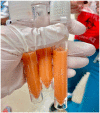A Rare Hemorrhagic, Orange-Colored Ascites, Challenging Traditional Ascitic Fluid Analysis
- PMID: 36691914
- PMCID: PMC9880565
- DOI: 10.1177/23247096221150630
A Rare Hemorrhagic, Orange-Colored Ascites, Challenging Traditional Ascitic Fluid Analysis
Abstract
Analysis of ascitic fluid can offer useful information in developing and supporting a differential diagnosis. As one of the most prevalent complications in patients with cirrhosis, ascitic fluid aids in differentiating a benign condition from malignancy. Both the gross appearance of the ascitic fluid, along with fluid analysis, play a major role in diagnosis. Here, we discuss a patient with liver cirrhosis, esophageal varices, hepatitis C, and alcohol abuse, who had a paracentesis performed, which revealed a turbid, viscous, orange-colored ascitic fluid that has not been documented in literature. Ascitic fluid is routinely analyzed based on gross appearance, cell count, and serum ascites albumin gradient (SAAG) score. An appearance of turbidity or cloudiness has commonly suggested an inflammatory process. In our case, fluid analysis revealed a red blood cell count of 24 250/mcL, further suggesting inflammation. However, it also revealed an insignificant number of inflammatory cells, with a total nucleated cell count of 14/mcL. This rich-orange color has posed a challenge in classification and diagnosis of the underlying cause of ascites, with one classification system suggesting inflammation, while another suggesting portal hypertension. Furthermore, we have traditionally relied on the SAAG score to aid in determining portal hypertension as an underlying cause of ascites. With a 96.7% accuracy rate, the SAAG score incorrectly diagnosed portal hypertension in this patient. In this article, we aim to explore how this rare, orange-colored ascitic fluid has challenged the traditional classification system of ascites.
Keywords: SAAG; abdominal paracentesis; ascites; orange; portal hypertension; serum ascites albumin gradient; spontaneous bacterial peritonitis.
Conflict of interest statement
The author(s) declared no potential conflicts of interest with respect to the research, authorship, and/or publication of this article.
Figures
Similar articles
-
The role of ascitic fluid viscosity in the differential diagnosis of ascites.Can J Gastroenterol. 2010 Apr;24(4):255-9. doi: 10.1155/2010/896786. Can J Gastroenterol. 2010. PMID: 20431815 Free PMC article.
-
Clinical usage of serum albumin to ascitic fluid albumin gradient and ascitic fluid total protein in pediatric ascites.Clin Res Hepatol Gastroenterol. 2021 May;45(3):101549. doi: 10.1016/j.clinre.2020.09.010. Epub 2020 Oct 23. Clin Res Hepatol Gastroenterol. 2021. PMID: 33268292
-
Role of serum-ascites albumin gradient in differential diagnosis of ascites.J Ayub Med Coll Abbottabad. 2012 Jul-Dec;24(3-4):97-9. J Ayub Med Coll Abbottabad. 2012. PMID: 24669623
-
Does this patient have bacterial peritonitis or portal hypertension? How do I perform a paracentesis and analyze the results?JAMA. 2008 Mar 12;299(10):1166-78. doi: 10.1001/jama.299.10.1166. JAMA. 2008. PMID: 18334692 Review.
-
Ascites in Children.Indian J Pediatr. 2016 Nov;83(11):1334-1340. doi: 10.1007/s12098-016-2168-1. Epub 2016 Jun 9. Indian J Pediatr. 2016. PMID: 27278239 Review.
References
-
- Runyon B. Diagnostic and therapeutic abdominal paracentesis. UpToDate; 2022. Accessed December 30, 2022. https://www.uptodate.com/contents/diagnostic-and-therapeutic-abdominal-p...
-
- Runyon B. Evaluation of adults with ascites. UpToDate; 2022. Accessed December 30, 2022. https://www.uptodate.com/contents/evaluation-of-adults-with-ascites#!
Publication types
MeSH terms
Substances
LinkOut - more resources
Full Text Sources
Research Materials



